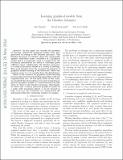Learning Graphical Models From the Glauber Dynamics
Author(s)
Bresler, Guy; Gamarnik, David; Shah, Devavrat
Download1410.7659.pdf (234.4Kb)
OPEN_ACCESS_POLICY
Open Access Policy
Creative Commons Attribution-Noncommercial-Share Alike
Terms of use
Metadata
Show full item recordAbstract
In this paper, we consider the problem of learning undirected graphical models from data generated according to the Glauber dynamics (also known as the Gibbs sampler). The Glauber dynamics is a Markov chain that sequentially updates individual nodes (variables) in a graphical model and it is frequently used to sample from the stationary distribution (to which it converges given sufficient time). Additionally, the Glauber dynamics is a natural dynamical model in a variety of settings. This paper deviates from the standard formulation of graphical model learning in the literature, where one assumes access to independent identically distributed samples from the distribution. Much of the research on graphical model learning has been directed toward finding algorithms with low computational cost. As the main result of this paper, we establish that the problem of reconstructing binary pairwise graphical models is computationally tractable when we observe the Glauber dynamics. Specifically, we show that a binary pairwise graphical model on p nodes with maximum degree d can be learned in time f(d)p[superscript 2]log p, for a function f(d) defined explicitly in this paper, using nearly the information-Theoretic minimum number of samples.
Date issued
2017-06Department
Massachusetts Institute of Technology. Department of Electrical Engineering and Computer Science; Massachusetts Institute of Technology. Laboratory for Information and Decision Systems; Sloan School of ManagementJournal
IEEE Transactions on Information Theory
Publisher
Institute of Electrical and Electronics Engineers (IEEE)
Citation
Bresler, Guy, David Gamarnik, and Devavrat Shah. “Learning Graphical Models From the Glauber Dynamics.” IEEE Transactions on Information Theory 64, no. 6 (June 2018): 4072–4080. © 1963-2012 IEEE
Version: Original manuscript
ISSN
0018-9448
1557-9654